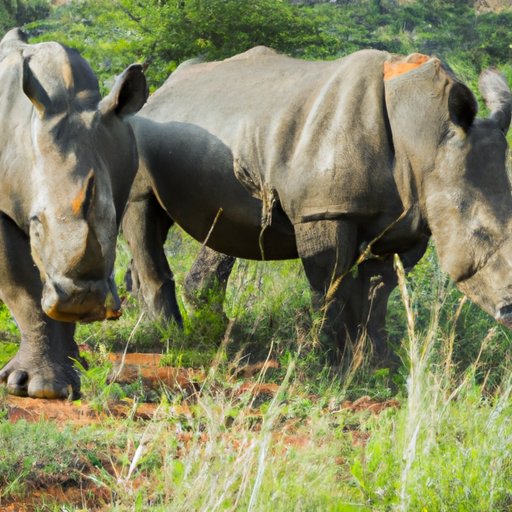Introduction
Rhinos are one of the most iconic animals in the world, and for centuries they have been revered for their strength and majestic presence. Unfortunately, due to poaching and other human-caused threats, there is now an estimated 29,000 rhinos left in the wild. This number is drastically lower than it was just a few decades ago, and conservation efforts are needed to ensure that rhinos are protected from further decline.

Overview of the Global Rhino Population
The global rhino population is made up of five different species: white, black, greater one-horned, Sumatran, and Javan rhinos. White rhinos are the most numerous, with an estimated 18,000 individuals remaining in the wild. Black rhinos are the second most populous, with about 5,000 individuals remaining. Greater one-horned rhinos are the third most populous, with approximately 3,500 individuals remaining. Sumatran rhinos are the most critically endangered, with only around 100 individuals remaining in the wild. Javan rhinos are also critically endangered, with only around 60 individuals remaining in the wild.
It is important to note that although the global rhino population is decreasing, some populations are increasing due to successful conservation efforts. For example, the white rhino population in South Africa has increased by over 7,000 individuals since 2010, and the greater one-horned rhino population in India has increased by over 1,200 individuals since 2012. These successes demonstrate that conservation efforts can be effective in protecting rhinos from further decline.
Causes of Rhino Decline
The primary cause of rhino decline is poaching for their horns, which are highly valued in traditional Asian medicine. Rhino horn is also used as a status symbol in some cultures, and as a result, demand for rhino horn has skyrocketed in recent years. This has led to an increase in illegal poaching, which has had a devastating effect on rhino populations.
In addition to poaching, habitat destruction is also a major threat to rhinos. As human populations expand, natural habitats are increasingly being converted for agricultural or urban development. This has resulted in a decrease in suitable habitat for rhinos, making them more vulnerable to poaching and other threats.

Conservation Efforts to Protect Rhinos
In order to protect rhinos from further decline, conservation efforts must focus on both reducing the demand for rhino horn and protecting remaining rhino habitats. Governments and organizations around the world are working together to implement anti-poaching measures, raise awareness about the plight of rhinos, and increase enforcement of existing laws. Additionally, many organizations are working to create and manage protected areas and reintroduce rhinos into former habitats.
Examining Different Species of Rhinos
In order to understand how best to protect rhinos, it is important to examine the different species of rhinos and their unique characteristics. White rhinos are the largest of the five species, weighing up to 5,000 kilograms, and are the most widespread species, found mostly in grasslands and savannahs in southern and eastern Africa. Black rhinos are smaller than white rhinos, weighing up to 2,000 kilograms, and are found mostly in woodlands and bushvelds in eastern and southern Africa. Greater one-horned rhinos are the third largest species, weighing up to 3,000 kilograms, and are found mostly in wetland habitats in northern India and Nepal. Sumatran and Javan rhinos are the smallest species, weighing up to 1,400 kilograms, and are found in tropical rainforests in Indonesia and Malaysia.

Understanding the Impact of Poaching
Poaching is the greatest threat to rhinos, and it is essential to understand the impact of this illegal activity in order to effectively combat it. Poaching is not only responsible for the direct killing of rhinos, but it is also responsible for disrupting social structures and reducing reproductive success. Poaching can also lead to a decrease in genetic diversity, as fewer individuals means less genetic variation within the population. In addition, poaching can cause local extinctions, as some populations may become too small to survive.
Conclusion
Rhinos are one of the world’s most iconic animals, yet their numbers are rapidly declining due to poaching and other human-caused threats. It is estimated that there are only 29,000 rhinos left in the wild, and conservation efforts are needed to ensure that these animals are protected from further decline. Governments, organizations, and individuals can all take part in protecting rhinos by raising awareness, supporting anti-poaching measures, and creating protected areas. By taking action, we can ensure that rhinos continue to thrive in the wild for generations to come.
Resources for Further Information
World Wildlife Fund: https://www.worldwildlife.org/species/rhinoceros
Save the Rhino International: https://www.savetherhino.org/
International Rhino Foundation: https://www.rhinos.


